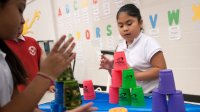Using Games and Design Challenges to Teach Students About Managing Conflict
By introducing students to activities that scaffold conflict, teachers can provide low-stakes lessons to prepare kids to navigate it in healthy ways.
Your content has been saved!
Go to My Saved Content.As second-grade teachers, we know that our students are exploring new relationships, changing social dynamics, and feeling the emotional weight that these interactions can have. Our students often encounter conflict as we ask them to take risks, stand up for what they believe in, and share their thoughts and opinions. With this in mind, we created and piloted a three-pronged hands-on approach to building both comfort and skills around managing conflict.
Our approach includes cooperative games and design challenges as well as good-to-know and problem jars. Each part is designed to allow our students to encounter consistent developmentally appropriate and varying types of conflict in order to build problem-solving skills. Throughout each activity, students are put in a variety of mixed groupings where they are confronted with increasingly complex challenges, last-minute changes, and peer leadership opportunities that shift the social dynamics. We are excited to share our approach and help other teachers implement these ideas.
The first few weeks of the year are all about community-building, developing routines, and getting to know our students better as people and learners. Cooperative games are a fantastic way to help students build relationships and begin to collaborate together as a group. As we thought through where we wanted to start, we knew that we wanted to focus on cooperative games that were easy to prepare, low cost, and easy to introduce and play quickly as either a whole or partial group. We wanted students to practice thinking flexibly, shifting roles, and finding success and failure collectively.
Some of our favorite games are the balloon challenge, the colored dots game, and the airplane game. While we introduced many of these games throughout the first semester, we revisited more complex versions, adjusted group sizes, and pushed our students to work through challenges with increasing independence as the year progressed.
Having had some experience with design challenges in the past, we knew that we could use them to push students in unique ways, and these activities tend to be excellent breeding grounds for conflict. We also love that they provide students an opportunity to work in small, fluid groupings and complete a challenge together using varying materials that are low cost and common.
Starting Point
To begin, students are introduced to the challenge and have a five-minute brainstorming period in which they create a plan as a group. After five minutes have lapsed, students then get their materials and begin creating for 10 to 20 minutes, depending on the challenge. There is never a winner who is celebrated or recognized; instead, we commend students for working together. Once the timer has ended, students reflect upon the process through both a group discussion and independently as part of an exit ticket.
Examples of design challenges that our students love are cup stacking, the Play-Doh–and–toothpick building challenge, and the egg-drop challenge. We found that both assigning leadership roles within their groups and increasing the difficulty level pushed students to overcome new challenges and discomfort. Feel free to be inspired by these activities, but change them as you see fit.
Assessment
We know that effective assessment tools help drive instruction and build our understanding of our students’ feelings and needs. To this end, we created multiple types of both formal and informal assessments that can be completed quickly and easily to help maintain consistency and encourage our students to be reflective about themselves as problem solvers.
Our students fill out an exit ticket based on the Likert scale that allows us to track how their understanding of conflict has changed over time after engaging in both cooperative games and design challenges.
Checking In
Finally, we know that students love their teachers, seek their approval, and enjoy sharing what is going on in their own lives. The good-to-know jar and problem jar offer students a space where they can check in with their own emotional experiences, identities, and culture, and use their real-life problems to share what is on their mind and help them navigate tricky feelings that they may feel uncomfortable sharing verbally.
The two jars are accessible to students throughout the week. Students contribute to these jars anonymously, and each student is encouraged to submit either a good-to-know or a problem throughout the week. On Fridays, we read through the problem jar as a class and talk through possible solutions or just acknowledge that some problems can’t be solved right away but that by talking about them, we are communicating that we will work harder to figure out a plan together.
Giving students a space to see that we, as their teachers, take their thoughts and opinions seriously and then connect their problems with real, immediate action is important in encouraging our students to be problem solvers. We also ask our students to consider how they naturally approach and respond to conflict. Providing them with this opportunity for self-reflection allows them to identify their personal strengths and challenges. The better we know each other, the more comfortable we’ll be with sharing how we feel and engaging in productive conflict.
